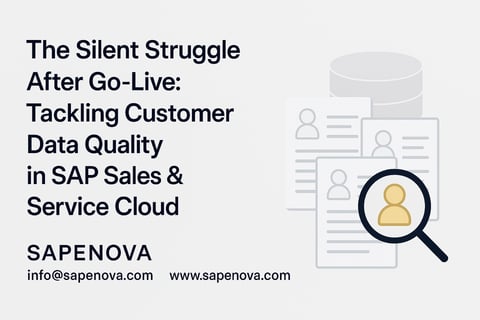Data Quality in SAP Sales and Service Cloud
The Silent Struggle after Go-Live: Refining Master data quality in SAP Sales and Service Cloud.


The Silent Struggle After Go-Live: Tackling Customer Data Quality in SAP Sales & Service Cloud
Based on our experience working with clients across industries, one of the most common—and underestimated—pain points businesses face after going live with SAP Sales Cloud and Service Cloud is poor customer master data quality, particularly duplicate and inconsistent customer records.
While the system implementation may be technically sound, many organizations find themselves struggling with duplicate customer accounts, conflicting versions of the same customer, and fragmented data spread across multiple systems like ECC, S/4HANA, CRM, and other external sources.
In today’s multi-system landscape, it’s not uncommon for customer master data to flow from ERP into SAP C4C while sales reps simultaneously create accounts manually in C4C for agility. Add third-party integrations into the mix, and soon you have multiple versions of the same customer across your ecosystem—each with slightly different data points, duplicate IDs, or missing information.
Why does this matter?
Duplicate and fragmented customer records have far-reaching consequences:
• Sales reps waste time choosing between duplicate accounts
• Incomplete customer history leads to poor service interactions
• Reports become inflated or inaccurate due to double counting
• Integration downstream (billing, service tickets) gets messy
• Sales and service teams lose confidence in their CRM
In short, poor customer data quality silently erodes the very ROI that the CRM system promised.
How can we address this?
At Sapenova, we’ve helped clients implement several proven strategies to reduce account duplication within SAP Sales Cloud and Service Cloud:
1. Enable Duplicate Check in C4C
Configure real-time duplicate detection during account creation, using rules based on name, email, address, or tax ID to flag or prevent duplicates.
2. Strengthen Master Data Governance (MDG)
Clean customer master data at the source (ERP) and harmonize records before replication into C4C.
3. Implement Filtering Logic in Middleware (CPI/PI)
Add duplicate detection or validation logic within SAP CPI to intercept duplicate records before they enter C4C.
4. Use Account Merge & Data Workbench in C4C
Regularly run duplicate detection reports in C4C, and leverage account merge tools and Data Workbench to consolidate records manually or in bulk.
These steps help reduce duplicates but often aren’t enough in a complex, integrated ecosystem.
The Game Changer: SAP Customer Data Platform (CDP)
While traditional duplicate checks operate at the system level, SAP CDP approaches the problem at the enterprise level.
SAP CDP acts as a centralized hub to unify customer data across multiple systems, channels, and touchpoints. Using advanced identity resolution algorithms, it:
• Identifies duplicate records across systems (ERP, CRM, Marketing, eCommerce)
• Merges them into a “Golden Record”—a single, accurate, complete view of the customer
• Keeps customer profiles continuously updated as new data arrives
• Enables downstream systems (like SAP C4C) to benefit from cleaned, harmonized customer data
In essence, SAP CDP doesn’t just clean data—it builds a unified customer identity that empowers marketing, sales, and service teams to work from the same trusted source of truth.
Why this matters for your business
With SAP CDP, businesses can:
Eliminate duplicate customer records across their landscape
Provide sales reps with a single, complete customer view
Deliver personalized service and marketing based on accurate data
Boost CRM adoption by building user confidence in data quality
Drive better reporting, analytics, and decision-making
Let’s Solve This Together
At Sapenova, we specialize in helping businesses overcome these post-go-live challenges in SAP Sales Cloud, Service Cloud, and the broader SAP CX ecosystem. From duplicate resolution strategies to SAP CDP implementation, we’re here to ensure your CRM data works for you—not against you.
Contact us today to explore how we can help your organization across the U.S. achieve cleaner data, smarter insights, and stronger customer relationships.
